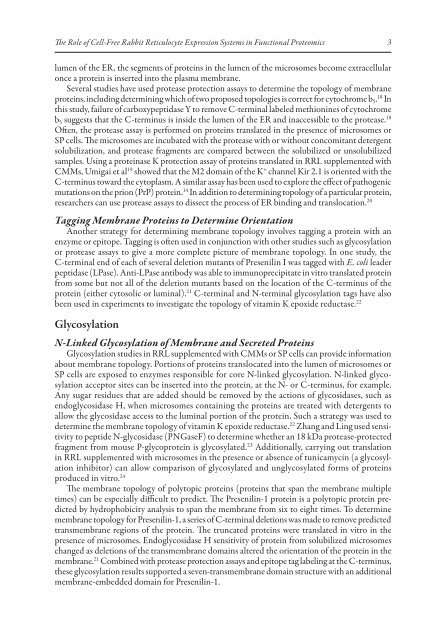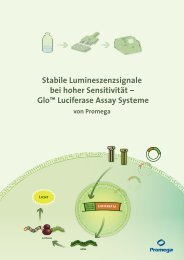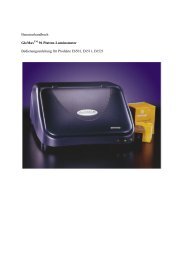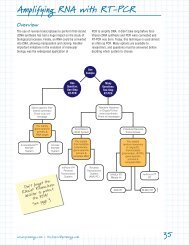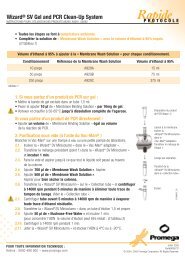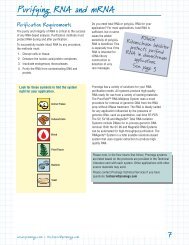The Role of Cell-Free Rabbit Reticulocyte Expression ... - Promega
The Role of Cell-Free Rabbit Reticulocyte Expression ... - Promega
The Role of Cell-Free Rabbit Reticulocyte Expression ... - Promega
You also want an ePaper? Increase the reach of your titles
YUMPU automatically turns print PDFs into web optimized ePapers that Google loves.
<strong>The</strong> <strong>Role</strong> <strong>of</strong> <strong>Cell</strong>-<strong>Free</strong> <strong>Rabbit</strong> <strong>Reticulocyte</strong> <strong>Expression</strong> Systems in Functional Proteomics<br />
lumen <strong>of</strong> the ER, the segments <strong>of</strong> proteins in the lumen <strong>of</strong> the microsomes become extracellular<br />
once a protein is inserted into the plasma membrane.<br />
Several studies have used protease protection assays to determine the topology <strong>of</strong> membrane<br />
proteins, including determining which <strong>of</strong> two proposed topologies is correct for cytochrome b 5. 18 In<br />
this study, failure <strong>of</strong> carboxypeptidase Y to remove C‑terminal labeled methionines <strong>of</strong> cytochrome<br />
b 5 suggests that the C‑terminus is inside the lumen <strong>of</strong> the ER and inaccessible to the protease. 18<br />
Often, the protease assay is performed on proteins translated in the presence <strong>of</strong> microsomes or<br />
SP cells. <strong>The</strong> microsomes are incubated with the protease with or without concomitant detergent<br />
solubilization, and protease fragments are compared between the solubilized or unsolubilized<br />
samples. Using a proteinase K protection assay <strong>of</strong> proteins translated in RRL supplemented with<br />
CMMs, Umigai et al 19 showed that the M2 domain <strong>of</strong> the K + channel Kir 2.1 is oriented with the<br />
C‑terminus toward the cytoplasm. A similar assay has been used to explore the effect <strong>of</strong> pathogenic<br />
mutations on the prion (PrP) protein. 14 In addition to determining topology <strong>of</strong> a particular protein,<br />
researchers can use protease assays to dissect the process <strong>of</strong> ER binding and translocation. 20<br />
Tagging Membrane Proteins to Determine Orientation<br />
Another strategy for determining membrane topology involves tagging a protein with an<br />
enzyme or epitope. Tagging is <strong>of</strong>ten used in conjunction with other studies such as glycosylation<br />
or protease assays to give a more complete picture <strong>of</strong> membrane topology. In one study, the<br />
C‑terminal end <strong>of</strong> each <strong>of</strong> several deletion mutants <strong>of</strong> Presenilin I was tagged with E. coli leader<br />
peptidase (LPase). Anti‑LPase antibody was able to immunoprecipitate in vitro translated protein<br />
from some but not all <strong>of</strong> the deletion mutants based on the location <strong>of</strong> the C‑terminus <strong>of</strong> the<br />
protein (either cytosolic or luminal). 21 C‑terminal and N‑terminal glycosylation tags have also<br />
been used in experiments to investigate the topology <strong>of</strong> vitamin K epoxide reductase. 22<br />
Glycosylation<br />
N‑Linked Glycosylation <strong>of</strong> Membrane and Secreted Proteins<br />
Glycosylation studies in RRL supplemented with CMMs or SP cells can provide information<br />
about membrane topology. Portions <strong>of</strong> proteins translocated into the lumen <strong>of</strong> microsomes or<br />
SP cells are exposed to enzymes responsible for core N‑linked glycosylation. N‑linked glyco‑<br />
sylation acceptor sites can be inserted into the protein, at the N‑ or C‑terminus, for example.<br />
Any sugar residues that are added should be removed by the actions <strong>of</strong> glycosidases, such as<br />
endoglycosidase H, when microsomes containing the proteins are treated with detergents to<br />
allow the glycosidase access to the luminal portion <strong>of</strong> the protein. Such a strategy was used to<br />
determine the membrane topology <strong>of</strong> vitamin K epoxide reductase. 22 Zhang and Ling used sensi‑<br />
tivity to peptide N‑glycosidase (PNGaseF) to determine whether an 18 kDa protease‑protected<br />
fragment from mouse P‑glycoprotein is glycosylated. 23 Additionally, carrying out translation<br />
in RRL supplemented with microsomes in the presence or absence <strong>of</strong> tunicamycin (a glycosyl‑<br />
ation inhibitor) can allow comparison <strong>of</strong> glycosylated and unglycosylated forms <strong>of</strong> proteins<br />
produced in vitro. 24<br />
<strong>The</strong> membrane topology <strong>of</strong> polytopic proteins (proteins that span the membrane multiple<br />
times) can be especially difficult to predict. <strong>The</strong> Presenilin‑1 protein is a polytopic protein pre‑<br />
dicted by hydrophobicity analysis to span the membrane from six to eight times. To determine<br />
membrane topology for Presenilin‑1, a series <strong>of</strong> C‑terminal deletions was made to remove predicted<br />
transmembrane regions <strong>of</strong> the protein. <strong>The</strong> truncated proteins were translated in vitro in the<br />
presence <strong>of</strong> microsomes. Endoglycosidase H sensitivity <strong>of</strong> protein from solubilized microsomes<br />
changed as deletions <strong>of</strong> the transmembrane domains altered the orientation <strong>of</strong> the protein in the<br />
membrane. 21 Combined with protease protection assays and epitope tag labeling at the C‑terminus,<br />
these glycosylation results supported a seven‑transmembrane domain structure with an additional<br />
membrane‑embedded domain for Presenilin‑1.


